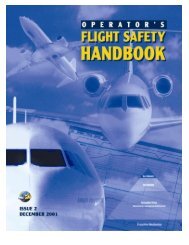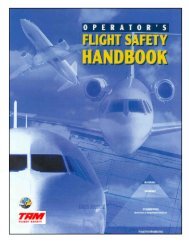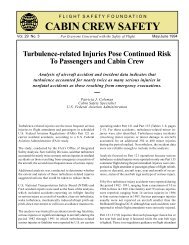Download PDF [10.9 MB] - Flight Safety Foundation
Download PDF [10.9 MB] - Flight Safety Foundation
Download PDF [10.9 MB] - Flight Safety Foundation
You also want an ePaper? Increase the reach of your titles
YUMPU automatically turns print PDFs into web optimized ePapers that Google loves.
U.K. Air Accidents Investigation Branch<br />
The teeter stops,<br />
shown in the<br />
photographs below,<br />
had split because<br />
of mast bumping,<br />
which occurs when<br />
rotor blades “flap<br />
downwards to an<br />
extreme angle and<br />
strike the mast,”<br />
the AAIB says.<br />
The accident flight began at 0958 local time,<br />
when the helicopter left Manston Airport for a<br />
flight to Fenland Airfield, about 240 km (130<br />
nm) northwest.<br />
The pilot told air traffic control, as the R22<br />
passed east of Cambridge Airport at 1118, that<br />
the helicopter was flying at 1,400 ft. That was the<br />
last radio transmission received from the pilot.<br />
The helicopter continued northwest, toward Fenland,<br />
and disappeared from radar about 1125.<br />
Witnesses on the ground southwest of the<br />
accident site said they saw the helicopter rapidly<br />
pitch and roll left and heard a “pop, as if it was a<br />
paper bag you banged in your hands,” the report<br />
said. Two witnesses also said that they saw objects<br />
separate from the helicopter before it fell,<br />
inverted, to the ground.<br />
The wreckage was found in a field 2 nm (4<br />
km) southwest of Ely. The helicopter was inverted<br />
and there were few ground marks, indicating<br />
that the helicopter had little horizontal speed<br />
just before the impact. Both main rotor blades<br />
had separated from the hub and were found several<br />
hundred meters from the main wreckage.<br />
One tail rotor blade also had separated and was<br />
not found, but the other was still attached. There<br />
was no indication that the main rotor had struck<br />
the tail boom, the accident report said, noting<br />
that “tail boom separation following main rotor<br />
contact has been a characteristic of a number of<br />
R22 in-flight structural failures.”<br />
Accident investigators said that weather<br />
conditions at the time of the accident included<br />
visibility of 30 km (19 mi), few clouds below<br />
25,000 ft and a light, westerly wind that was<br />
FLIGHTSAFETY.ORG | AEROSAFETYWORLD | MAY 2013<br />
CAUSALFACTORS<br />
not considered strong enough to have generated<br />
low-level turbulence. They said either wake<br />
turbulence or a need for a sudden maneuver to<br />
avoid another aircraft was highly unlikely.<br />
The accident helicopter was manufactured<br />
in 1988; at the time of the accident, the airframe<br />
had been in operation for 6,407 hours and the<br />
engine, for 1,595 hours. The last maintenance<br />
check was a 50-hour check completed Dec. 6,<br />
2011 — 28 flight hours before the accident. No<br />
significant defects were found, the report said.<br />
Maintenance records included no mention<br />
of any disturbance of the pitch control links<br />
during the year before the accident and showed<br />
that the last “known disturbance” of the rotor<br />
system occurred in April 2010, when the main<br />
rotor blades were removed for replacement of<br />
the spindle bearings.<br />
Examination of the wreckage found damage<br />
to the main rotor that showed that the main<br />
rotor blades had “flapped to extreme up and<br />
down angles prior to separation,” the accident<br />
report said.<br />
This condition — known as main rotor divergence<br />
— has several causes in helicopters such as<br />
R22s, which have “teetering, two-bladed rotors,”<br />
the report said, citing low-g maneuvers, low-rotor<br />
rpm, turbulence and “large abrupt control inputs.”<br />
The report said it was “possible that a combination<br />
of low rpm, an abrupt control input<br />
and low-g caused the main rotor divergence.<br />
… If carburetor ice caused a loss of rotor rpm,<br />
this would have triggered the low rpm audio<br />
warning, and this warning sounds like the stall<br />
warning in some light fixed-wing aircraft. The<br />
response of a fixed-wing pilot to a stall warning<br />
is often to push forward on the controls to unstall<br />
the wing. This would be an inappropriate<br />
response from the pilot in these circumstances<br />
but understandable given that the vast majority<br />
of his flying was in fixed-wing aircraft.”<br />
The report said that low rotor rpm “could<br />
explain why the pitch link failed in the way that<br />
was observed” — with the separation of the no.<br />
1 pitch link and indications that the attached<br />
bolts had failed because of overload resulting<br />
from the application of considerable force.<br />
| 35


![Download PDF [10.9 MB] - Flight Safety Foundation](https://img.yumpu.com/18550968/37/500x640/download-pdf-109-mb-flight-safety-foundation.jpg)

![Download this Issue [PDF 7 MB] - Flight Safety Foundation](https://img.yumpu.com/18859635/1/190x245/download-this-issue-pdf-7-mb-flight-safety-foundation.jpg?quality=85)
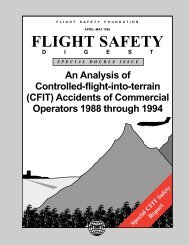
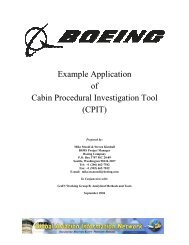
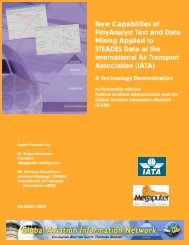
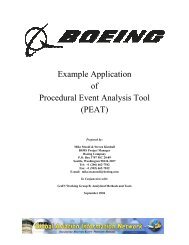

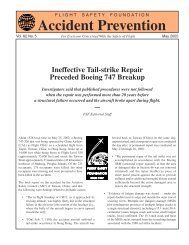
![Download [PDF 8 MB] - Flight Safety Foundation](https://img.yumpu.com/18859366/1/190x245/download-pdf-8-mb-flight-safety-foundation.jpg?quality=85)
